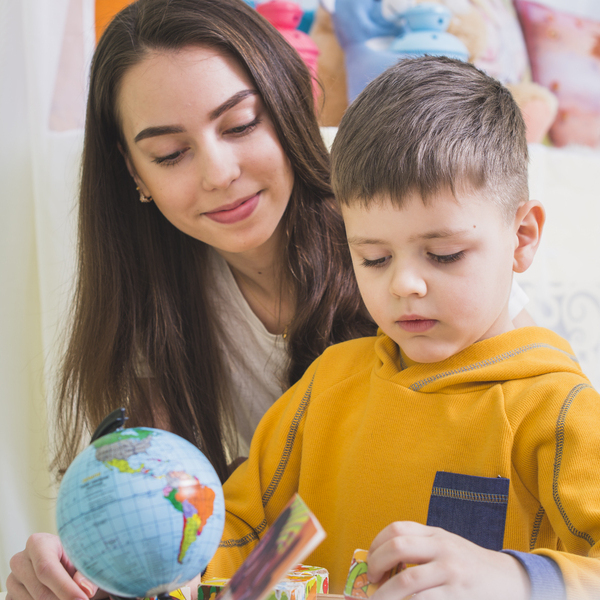
Language Development in Toddlers
Hearing the first words from your baby’s mouth is an unforgettable experience. Inspired by this experience and understanding the need for communication, parents are very keen to develop the communication skills of their toddlers. Communication is a two-way process; in this context, toddlers’ parental behavior will determine the learning pace of their child’s communication skills.
Nonverbal Gestures
Words are one part of communication that is incomplete without expression. Children’s expressions, like eye contact and body language, give them complete meaning. Fostering a child’s ability to recognize these additional aspects of communication is vital to nurturing the behavior for speech production.
This ability of the child to recognize the additional aspect of communication is rooted in the early behavior of kids. Behaviors like crying when they are hungry and when parents respond to these feelings make toddlers aware of the importance of the behavior in communication.
Thus, toddlers begin to incorporate behavioral gestures into their communication from the beginning. This makes it necessary for the parents to foster this behavior in addition to developing the communication skills of their toddlers.
Speaking Developmentally
Understanding symbolism in language is important. Language is symbolic, which implies that every word represents an object or feeling. This highlights another aspect that to speak, an image is created in the mind of the speaker, and then the production of speech takes place.
Thus, the parents need to indulge in some sort of imaginative play activity with the toddlers to foster imaginative practices. This will enable the child to develop their capability to represent objects mentally and symbolically.
A closer look into the toddlers’ playing skills or activities will help the parents determine the child’s readiness to speak or communicate. If the child is mostly involved in making noise with objects to draw attention,. This highlights that the kid is not ready to communicate, as his intent for communication is still developing.
Provision of opportunities
The provision of opportunities is vital to fostering communication skills in kids. This can be done by involving kids in routine activities. For instance, put the toddler’s favorite cup away from the kid. Bring him some food, and let the kids ask to bring their favorite cup.
Similarly, you can change the arrangement of the things used by kids. Try to put toys or their favorite storybook in a higher place so that they will not be able to grab them on their own. This will compel the child to ask for them, forcing them to utter words to fulfill their needs.
Break the sequence or habit. If you are dressing a child or creating his favorite puzzle, try to miss a phase. For example, you can forget to put on socks or create the puzzle in the wrong sequence. This will trigger a reaction in the mind of a child, and he will begin to ask to correct the puzzle or his dressing.
Methods to expand language skills
When improving the capabilities of your kids concerning communication, don’t set two broad or two narrow goals. For instance, if the child peaks two words, practice activities that can encourage them to speak three words. This will not overburden them and keep them engaged in the process of learning new words.
Make sure that the communication remains fun. Observe what the toddlers like most and devise a communication-building strategy that is in line with their interests. If they are more interested in the toys, focus on them by communicating and asking about their attributes.
Talking and communicating with others should be fun! Remember, language is something kids acquire naturally, so we want to watch what they’re interested in, observe and listen to how they communicate, and help bring them to the next level of language skills.
Imitate strategy
Copying what children are doing to communicate is a good step in promoting and managing communication. If the toddler makes noises, such as banging a spoon on the table, you can do it too. Similarly, if the child is murmuring some words, you can also imitate them
This develops a sense of recognition among children that their way of communicating is being recognized or approved. It will also enable parents to take control of the process by participating in it and learning to speak and follow words uttered by you to build their vocabulary.
Interpret strategy
Most children point at objects to acquire the things they want. You can help them by making them aware of what they want. If he is pointing at a spoon, say the word spoon to make the child aware of what he is asking. In this way, the child will recognize what he wants and begin to speak.
Expanding sentences strategy
Expand the words spoken by your child by adding relevant words or adjectives to their spoken words. If the child says teddy bear, you can say a big white teddy bear. In this way, you are expanding his understanding of the object that he wants to acquire and the relevant attributes of the object.
This can be used in another format. If the toddler speaks the word car door open, you can respond in a way that the door of the car is opened. In this way, you are making the child aware of the correct use of words by engaging with them in routine communication.
Describing strategy
This is a very interesting strategy to follow. You can also call this strategy a commenting strategy. When the toddler is riding his cycle,. You can comment like you are riding your blue bicycle with a black seat inside the house. This will make them aware of the whole activity.
The adaptability of this strategy is amazing. Toy play sets are very common toys, liked by many children. If the toddler girl is playing with his doll house,. Do comment on what he is doing. You can say you are taking the doll to the living room so she can watch TV with the family.
The thinking process of the toddler got very organized as he began to understand the scope of his activities.
Negative Talk
Prevent negative behavior so that the child remains interested in the whole process of communication. If the toddler says that the color of the car is pink, don’t say it is not pink. Instead, you can use a more positive tone. Emma loves to go in the pink car to her favorite toy store.
Contingent response or gesture
These types of responses act as motivation. If the toddler speaks a new word, give them a clap to appreciate their learning. This will create an emotional reaction in the child’s mind; he will be eager to learn new words.
This will also improve child participation, as he will be more keen to learn about new words and begin to listen very carefully to the words his family members are speaking. This strategy will help toddlers to develop vocabulary at a more rapid pace, improving their communication ability significantly.
Conclusion
Communication skills are vital for a child’s mental development. It depends on a child’s ability to learn but also requires a supportive environment to gain this skill. Parents have to exercise positive behavior that encourages the child to practice these skills conveniently so they can develop them at a rapid pace.

